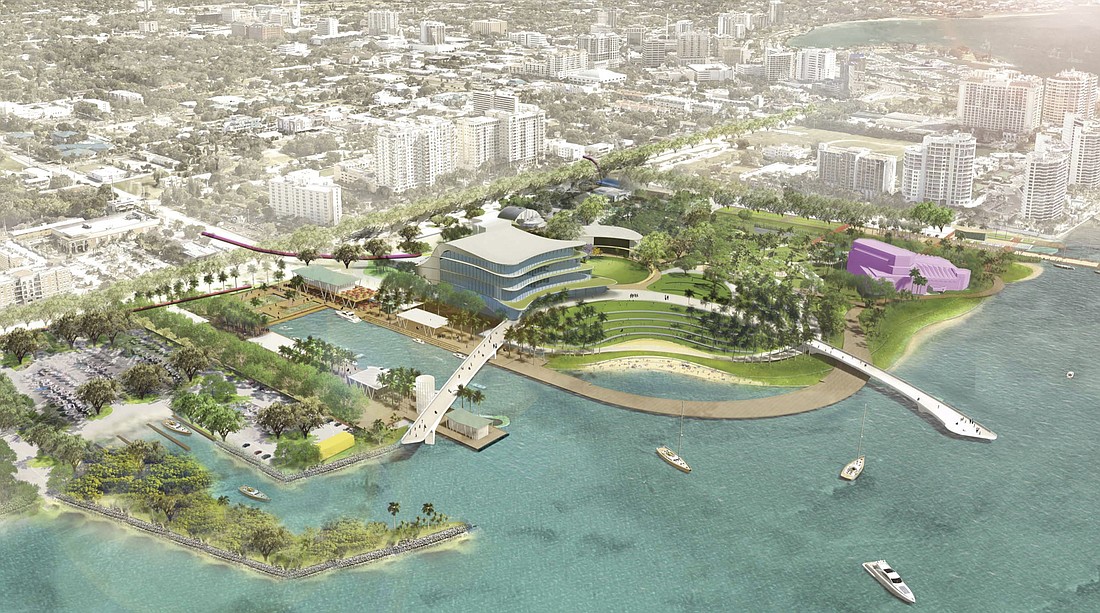- May 23, 2025
-
-
Loading

Loading

Even on the most optimistic timeline, there’s at least two more years before the first phase of The Bay Sarasota’s master plan is built out.
The next year will be a bridge year for those involved with producing a vision for redeveloping more than 50 acres of city-owned land surrounding the Van Wezel Performing Arts Hall.
In 2018, there was the excitement of engaging the public in the planning process and gaining approval from the City Commission. If all goes according to schedule, the 2020s will bring the opening of various segments of a new waterfront park, expected to cost between $100 million and $200 million.
But although 2019 may lack those types of headline-grabbing milestones, The Bay’s leaders intend to stay busy.
“It may seem a little quiet, but we’re going to be doing a lot of work behind the scenes,” said Bill Waddill, The Bay’s managing director.
Some of the work is organizational. Gone is the Sarasota Bayfront Planning Organization, the independent entity that partnered with the city to produce the master plan. In its place is The Bay Conservancy, the independent entity that will partner with the city to oversee the implementation of the master plan and manage the property in perpetuity.
The Bay Conservancy has already announced its initial leaders, individuals including Startup CEO A.G. Lafley and Chairwoman Cathy Layton, who were previously involved with the Sarasota Bayfront Planning Organization. In early 2019, the group hopes to formalize the terms of its agreement with the city.
The Bay Conservancy hopes to start design work early in the new year, as well. Waddill said the group intends to begin the process of producing final plans for the first phase of the project in February. The Bay intends to once again team with Sasaki Associates Inc., the planning firm that helped produce the overarching master plan the city adopted in September.
Waddill expects the design and permitting work to take between 12 and 18 months, with construction taking nine to 12 months. He said the plans could start going through the city’s public development review process in the spring or summer. The first phase of the project includes a linear park along Boulevard of the Arts, a pier extending over the water and more.
That schedule gives The Bay time to focus on a third item it must tackle in 2019: fundraising. The first phase is expected to cost around $20 million. The overall project could cost 10 times that figure without including a performing arts center.
Although The Bay has a general sense of how it would like to phase the construction, Waddill said the group intends to be flexible as it pursues funding for the long list of projects within the master plan. Already, The Bay has targeted a grant it believes could help pay for improvements to a mangrove bayou near the southwest portion of the site.
“We’re going to follow the money and adapt as opportunities present themselves,” Waddill said.
The Bay has outlined a mix of funding sources it’s targeting as it seeks to pay for the project over the next 10 to 15 years. Preliminary estimates state 40-50% of that funding should come from philanthropic sources, which leaves public sources to pay for as much as 60% of the bayfront redevelopment.
The group has had discussions with city and county officials about funding. Perhaps most significantly, The Bay has proposed creating a tax-increment-financing district, which would collect growth in city and county property tax revenue from the area around the site and invest that money into the project.
At a Dec. 14 County Commission retreat, members of the board discussed the possibility of entering into a funding agreement for the bayfront project. Although there were some questions — Commissioner Al Maio said he didn’t want to establish a long-term agreement that would bind the decisions of future commissions — the board directed staff to continue discussing the proposal with The Bay. Waddill said he hoped to make a presentation to the County Commission in early 2019.
The County Commission has previously expressed some hesitance about creating new TIF districts, but Commissioner Charles Hines suggested The Bay may be exceptional enough to justify the funding strategy.
“We need to be able to say this one is so unique, so big, it will make a regional impact beyond just downtown Sarasota,” Hines said.
While all that work is ongoing, Waddill said The Bay would also look for opportunities to keep the public apprised on the progress of implementing the master plan.
“Even though we’re in a kind of quiet period from a public standpoint, we still want to let people know: Stay tuned,” Waddill said. “It’s coming.”